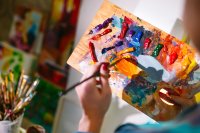Boosting Resilience Through Creativity
Creativity is a resource for coping with stress—and it can be as simple as just asking questions to enhance our sense of wonder.
Many educators are concerned with managing stress and preventing burnout, well aware as we are of the demands of the profession and the high rate of turnover in schools. We know we need to sleep, eat well, exercise, and maybe meditate, and those habits are certainly useful in cultivating resilience, which is the ability to tackle adversity and emerge stronger than before.
But there’s another way we can cultivate resilience that’s often overlooked, which is to boost our creativity. Creativity unlocks inner resources for dealing with stress, solving problems, and enjoying life. When we are creative, we are resourceful, and we problem solve in new and original ways.
Why Creativity Cultivates Resilience
Creativity is both a habit—something we do—and a disposition—an attitude or way of being. It’s hard to say when it shifts from being a habit into a disposition, or whether it can be a disposition without being acted on through habits. Something I discovered through recent writing and researching is that just about every study on resilient people identifies creativity as a key trait, behavior, or disposition.
Here’s why: Creative processes enable us to see the root of a problem or see a situation in a different light. This allows us to make connections between seemingly unrelated phenomena and gain new perspectives. This includes all of the challenges you face in the classroom—behavior and assessment management, organization, and the workload. What if you could draw on additional resources within yourself to figure out new and innovative ways to deal with these issues? Focusing on your creativity might allow you to do that.
Another argument for indulging in creativity: It’s good for your brain because it stimulates alpha waves, signals in the brain that closely correlate with states of relaxation. Scientists have found that when people are relaxed, they’re much more likely to have big aha moments, when impossible problems seem to solve themselves. This is why when you’re going around and around a problem, the best thing to do is take a walk, play table tennis, or take a long shower—these activities produce alpha waves in your brain.
In addition, numerous studies show that activities such as drawing, knitting, and journaling raise serotonin levels and decrease anxiety, factors that contribute to resilience—our ability to deal with our problems in a way that makes us feel like the next time they come around, we’ll have a better ability to tackle them.
How Can I Cultivate More Creativity?
Creativity is a habit that needs to be developed. Many people have a fear of being creative (“But I’m not good at art”) and don’t see creative activities as a valuable way to spend time. If you’re in this group, start little by little, take a class, or even just try to appreciate art more. As you nurture your own creativity, you can incorporate it more into your instruction, your staff meetings, and your weekends, and you’ll become more resilient.
Here are a few ways to foster a creative mindset inside and outside of your classroom:
- Ask questions: It’s said that at the age of 5 children ask 120 questions a day, at age 6 they ask 60 questions a day—and at 40 adults ask only four questions a day. Embrace a beginner’s mind and ask questions. Pay attention to questions other people ask. Collect questions you find compelling.
- Be curious: Collect scraps of ideas, fragments of words, leaves and petals, images and scents. Put them in a drawer or a little box in your mind. Don’t look for connections, but be open to allowing these scraps to form together in new ways. Combining ideas and making connections are key practices of creativity.
- Experiment, fail, and take notes: As Thomas Edison said, “I make more mistakes than anyone else I know, and sooner or later, I patent most of them.” Edison was a prolific inventor and innovator and a master at learning from failed experiments. When he died, he left 3,500 notebooks containing details of his ideas and thoughts. If you follow your curiosity, experiment with ideas, and learn from your mistakes, the quality of your creativity will vastly improve.
Let me make a final plea: Indulge in creativity because it is your birthright. Human beings express themselves creatively; creative expression is a part of who we are. You won’t find a single culture in the world in which people don’t create expressions of beauty. In the same way that I hope you tend to your body and care for your emotional self, I urge you to nourish your creative spirit, and I assure you, it’ll make you more able to deal with the stressors of teaching.
